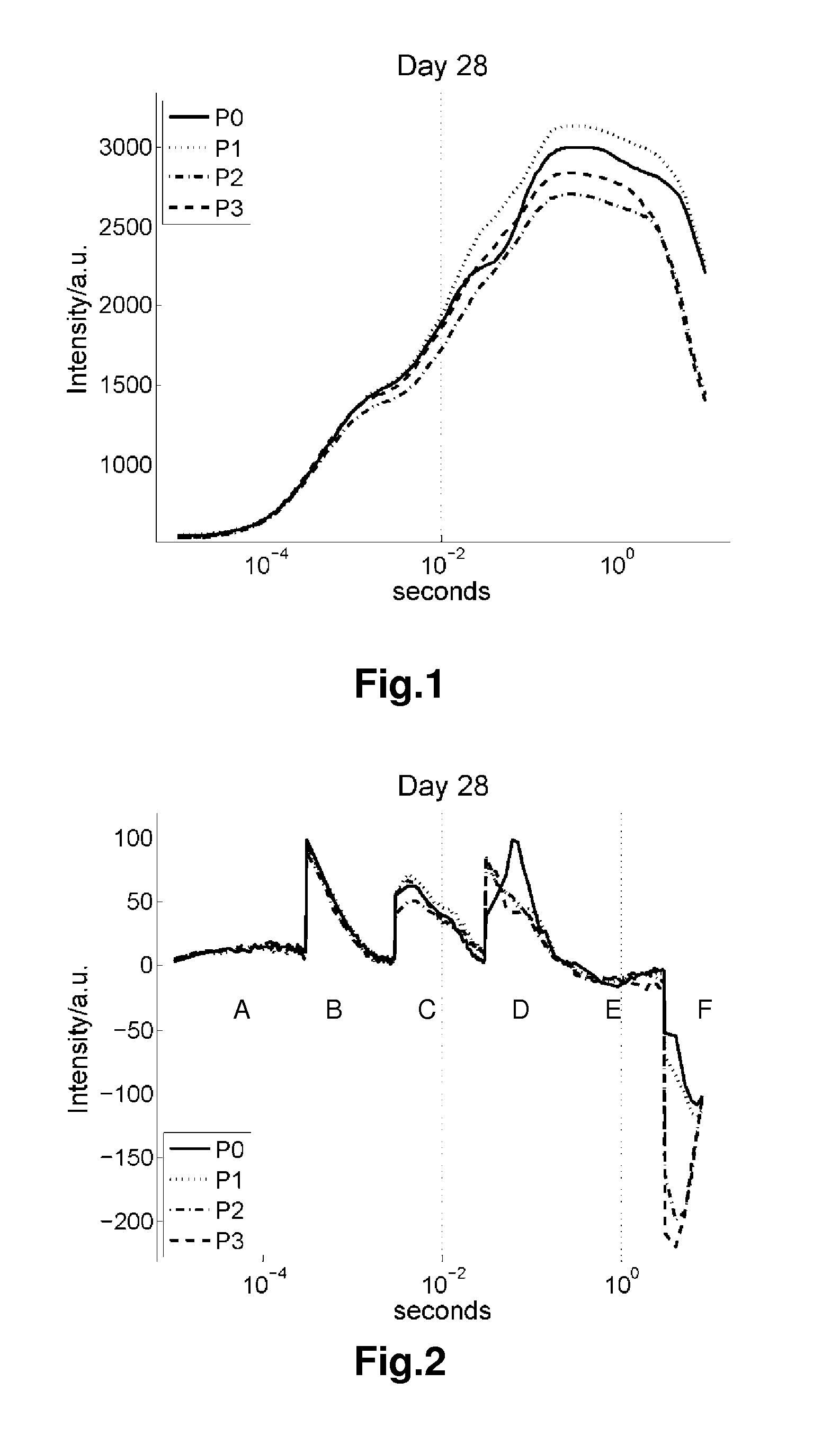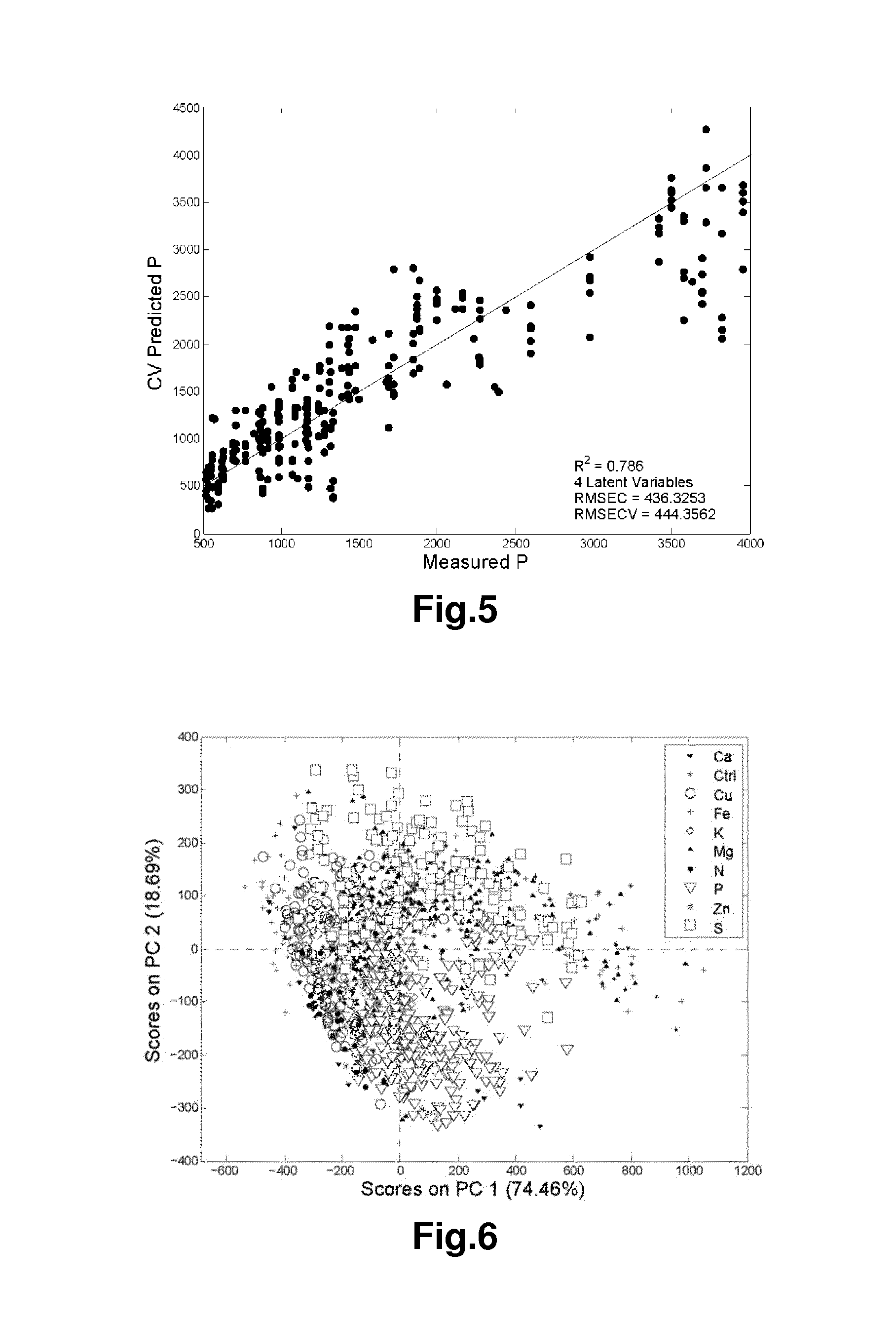Method and device for determining a nutritional state of a plant
- Summary
- Abstract
- Description
- Claims
- Application Information
AI Technical Summary
Benefits of technology
Problems solved by technology
Method used
Image
Examples
examples
Recording of Fluorescence Induction Transients
[0048]In all examples, chlorophyll a fluorescence transient measurements were performed using the commercially available Hansatech Instrument “Handy PEA”. Using the dark adaption clips fitting this instrument, the tissue samples to be analysed were initially dark adapted for at least 20 minutes, thereby effectively stopping all photosynthesis activity and maximizing the intensity increase of the OJIP-rise. When measuring, the sensor unit of the Handy PEA is placed on the dark adaption clip, thereby allowing the tissue sample to be exposed to the sensor and diodes without letting light in. Initially, a background level was determined by using a short flash of non-actinic light and measuring the response from the tissue sample, and the gain of the detector was adjusted accordingly.
[0049]After this initial adjustment, the actual measurement was conducted by illuminating the exposed leaf by three red LED's that are optically filtered to a ma...
experiment 1
ber
[0057]The germinated plants were transferred to 32 cultivation units, each containing 10 plants, and divided into two groups (A and B) with 16 units each (day 1). Group A was cultivated in a climate chamber under normal light settings (400 μmol photons m−2 s−1) and a constant temperature of 20° C. during the whole experiment. Group B was cultivated in a climate chamber with the same initial settings as A, however, when the reduced P levels were induced, the settings were changed into high light intensity (750 μmol photons m−2 s−1) and a constant temperature at 15° C. Twice a week the positions of the units were randomized within each chamber.
[0058]The 16 units in each climate chamber were divided into the four different P treatments (Control, P1, P2, and P3). For the first 10 days, P1, P2, and P3 units were all supplied with nutrient solution P1, to avoid a luxury uptake of P in the pre-cultivation phase but allow the production of healthy biomass. After 10 days, the three limite...
experiment 2 — greenhouse
Experiment 2—Greenhouse
[0060]The germinated plants were transferred to 16 cultivation units each containing 4 plants (day 1), and were cultivated under the same greenhouse conditions as for the germination period. The 16 cultivation units were divided into the four different phosphorus treatments (Control, P1, P2, and P3), and their positions were randomized twice a week.
[0061]All four different treatments were given control-level nutrient supply during the first ten days. On day 10, the P1, P2, and P3 levels were induced using their respective nutrient solutions. On day 21, phosphorus was removed completely from the P1-3 treatments. On day 28, all cultivation units were supplied with control-level nutrient concentrations to observe a potential effect of phosphorus re-supply.
[0062]The plants were sampled four times during the experimental period, at day 21, day 23, day 28, and day 30. One plant from each cultivation unit was harvested, and chlorophyll a measurements were performed o...
PUM
 Login to View More
Login to View More Abstract
Description
Claims
Application Information
 Login to View More
Login to View More - R&D
- Intellectual Property
- Life Sciences
- Materials
- Tech Scout
- Unparalleled Data Quality
- Higher Quality Content
- 60% Fewer Hallucinations
Browse by: Latest US Patents, China's latest patents, Technical Efficacy Thesaurus, Application Domain, Technology Topic, Popular Technical Reports.
© 2025 PatSnap. All rights reserved.Legal|Privacy policy|Modern Slavery Act Transparency Statement|Sitemap|About US| Contact US: help@patsnap.com



